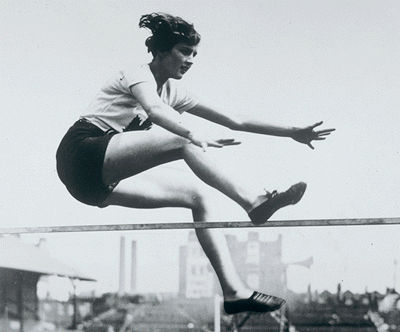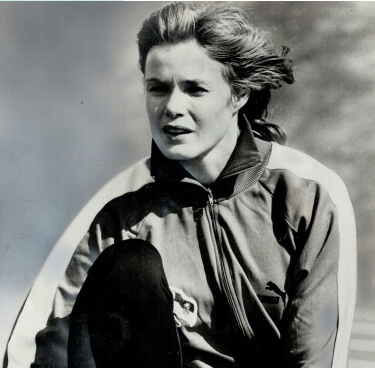Côté, Gérard
Gérard Côté, athlete, long-distance runner and marathoner (b at St-Barnabé-Sud 27 July 1913, d at St-Hyacinthe Qué 12 July 1993). When he was an adolescent, after his mother's death, Gérard Côté moved with his family to St-Hyacinthe. Much to his dismay, the young man had to drop out of school to begin working. He turned to running to stay in shape. In the fall of 1931, the professional runners of the Peter Dawson Marathon were in St-Hyacinthe for a leg of that great 800 km relay race, and the moment he saw the runners, Gérard felt a surge of adrenaline and knew that RUNNING would be his sport from then on.A few weeks later, he won his first race. It was held between the towns of Ste-Madeleine and St-Hyacinthe. In early 1932, he registered for his first snowshoe race.
1935 was a significant year for him. He participated in several national competitions: the Chiclets Marathon in Montréal for the Canadian championship, the Toronto Marathon and the Yonkers Marathon, in which he finished 12th. In April 1936, he finished 23rd in the prestigious Boston Marathon, which he was running for the first time. He returned to Toronto on June 20 and finished fifth in the Canadian OLYMPIC trials. Because he was not selected for the team, the newspaper La Patrie held a public fund-raising campaign to collect money to send the French-Canadian athlete to Berlin for the Olympic Games. Unfortunately, there was not enough money, so his Olympic dream was not to be. Nonetheless, the Maskoutan runner displayed his determination when he won the Chiclets Marathon in Montréal the following October. This was his first important victory; he became Canadian champion and broke the Québec record.
That victory, combined with second place in the Yonkers Marathon a few weeks later, would become the spark that set off an international career. Some US journalists favoured him as the winner of the Boston Marathon. He managed to do it in 1940 in the time of 2 hours, 28 minutes and 28 seconds, and he won the Yonkers Marathon in November. Those two victories brought him great prestige; he had reached the height of sports excellence in Québec. The rest of the country recognized his achievements when the Canadian press awarded him the LOU MARSH TROPHY, which is awarded to the Canadian athlete of the year. From then on, Gérard Côté was also recognized as the Canadian grand champion. Caught at a disadvantage, Québec Francophones tried to find a similar way of highlighting his achievements. Some important members of the Francophone sports scene combined efforts to honour the runner and in February 1941, Gérard Côté was the first recipient of the Joseph Cattarinich memorial trophy, awarded to the most illustrious French-Canadian athlete of the year.
With the cannons of World War II booming, Gérard joined the Canadian Armed Forces in the fall of 1942. A few weeks after he joined, he volunteered for the battlefield, but the Canadian army had other plans, naming him a physical fitness instructor. In Québec, passions were running high over Canada's conscription law, the Military Service Act. The military authorities wanted to benefit from the athlete's high media visibility, so they let him run under the army's colours and gave him the time he needed to train. In 1943, Gérard Côté, now a sergeant, won the Boston and Yonkers Marathons while wearing the Maple Leaf and the Army name on his clothing.
However, under some social pressure, the army modified its rules by prohibiting soldiers from participating in civilian sporting events. In the spring of 1944, Gérard Côté took leave and returned to Boston under his own steam. Running unaffiliated, he won that marathon for the third time.
During a stay in England, he received permission to run again. Competing against renowned British runners, Gérard Côté earned three victories in six races. He returned to Canada at the end of the winter of 1946, just in time for the Boston Marathon, in which he had to settle for third place. A few months later, he won the title of US marathon champion with his third victory in Yonkers.
In 1948, Gérard Côté was finally able to realize his Olympic dream when the city of London was selected to host the 14th Summer Olympics. Before flying to England, he won the Boston Marathon in April, the Los Angeles Marathon in May and the Hamilton Marathon in June. Despite his victory in Boston, the Amateur Athletic Union of Canada required him to run in Hamilton to be selected for the Games. Unfortunately, the short time between those three marathons and the Olympic marathon was detrimental for him. Suffering from a leg injury during most of the race, he displayed courage and proudly wore the Canadian colours to the finish line, where he came in 17th. Having lost his chance to win an Olympic medal, that extremely painful loss, both physically and emotionally, remained the one that affected him the most.
After his Olympic experience, Gérard Côté felt very fatigued and questioned his career but did not quit.
He competed in the St-Hyacinthe Marathon year after year and took on other challenges such as the British Empire Games (later the COMMONWEALTH GAMES) in Auckland, New Zealand (1950), and in Vancouver (1954), where injury made him abandon the race. His last experience in international games turned out to be upsetting because, for the first time, he did not finish a race. He participated in short-distance races while waiting to hang up his running shoes at the end of his 25-year career. His last race was the St-Hyacinthe Marathon in the fall of 1956. That race (named A Quarter Century") took place on the same course as his first road race in 1931. Twenty-five years later, he did not win the race, but he clocked a faster time!
Even after the runner had retired, he continued to organize the St-Hyacinthe Marathon until 1975. Attracting runners from Québec, Ontario and the United States, the race was one of the most prestigious marathons in Canada for some time. Several times, the Canadian marathon championship was decided there (42.2 km).
At the start of the 1980s, when running was on the verge of becoming a popular sport, some individuals were working on forming a Québec provincial race circuit. The organization, with Loto-Québec sponsorship, hired the valiant runner as circuit ambassador. For 10 years, Gérard Côté had the opportunity to associate with the new generation of runners.
His position in this organization allowed the Québec public to reconnect with his achievements. His combined 192 000 km of racing, four Boston Marathon victories and three US championships make him a symbol of excellence in Québec and the rest of Canada.
In 1976, the organizing committee of the Montréal Olympic Games bestowed a significant honour upon him: right before the Games opened, at the end of the Olympic flame relay, Gérard Côté lit the cauldron on Mount Royal before millions of television viewers.
Over the years, numerous organizations have recognized his achievements and legendary endurance. In 1955, he was inducted into the CANADIAN OLYMPIC HALL OF FAME. The following year, Canada's Sports Hall of Fame welcomed him. In 1989, he was decorated with the ORDRE NATIONAL DU QUÉBEC. In the fall of 1990, the Governor General awarded him the ORDER OF CANADA Member insignia. A few months later, in 1991, he was among the first inductees into the Québec Sports Hall of Fame. Then, in 1993, he received the Commemorative Medal for the 125th Anniversary of Confederation.
Gérard Côté died on 12 July 1993 in St-Hyacinthe one week after the inauguration of a bikeway named in his honour.

 Share on Facebook
Share on Facebook Share on X
Share on X Share by Email
Share by Email Share on Google Classroom
Share on Google Classroom


